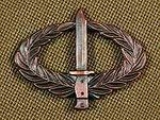
Infantry combat badge
Encyclopedia
The Infantry Combat Badge (ICB) is awarded to members of the Australian Army
for service as an Infantryman in warlike operations.
In January 1970, Lieutenant General
Sir Thomas Daly KBE, DSO, as the Chief of the General Staff and part of the Military Board, laid the original basis for the ICB. He is recorded in the minutes as saying, "whilst he appreciated the views expressed (in the Military Board) it was to be borne in mind that the proposed badge was meant to be a visible distinction for the infantryman and was not a general combat badge. He said the other corps had their responsibilities and neither their worth nor performance, were in question. However he could not accept that an infantry award should be granted to members of other corps unless they qualified for it as infantrymen."
The Army Combat Badge (ACB) was instituted in 2005 to recognise the service of members of other corps who are posted to a Combat Team or Battle Group
engaged in combat operations in an active theatre of operations.
who, in an infantry posting as part of an infantry battalion were deployed for, at least, 90 days to an operational area and subsequently awarded the Infantry Combat Badge.
Australian Army
The Australian Army is Australia's military land force. It is part of the Australian Defence Force along with the Royal Australian Navy and the Royal Australian Air Force. While the Chief of Defence commands the Australian Defence Force , the Army is commanded by the Chief of Army...
for service as an Infantryman in warlike operations.
History
The ICB was first established in July 1970 for recognition of infantry service in battle or on operations, following the decision of the Military Board in January 1970. The role of the infantry is to seek out and close with the enemy, to kill or capture him, to seize and to hold ground, to repel attack, by night and day, regardless of season, weather or terrain. The purpose of the ICB is to recognize this unique role and the particular training, skills and hardships attendant upon service as an infantryman. In exceptional circumstances, the ICB may be awarded to members of other corps, where they have qualified for it as infantrymen.In January 1970, Lieutenant General
Lieutenant General (Australia)
Lieutenant general is the second-highest active rank of the Australian Army and was created as a direct equivalent of the British military rank of lieutenant general. It is also considered a three-star rank....
Sir Thomas Daly KBE, DSO, as the Chief of the General Staff and part of the Military Board, laid the original basis for the ICB. He is recorded in the minutes as saying, "whilst he appreciated the views expressed (in the Military Board) it was to be borne in mind that the proposed badge was meant to be a visible distinction for the infantryman and was not a general combat badge. He said the other corps had their responsibilities and neither their worth nor performance, were in question. However he could not accept that an infantry award should be granted to members of other corps unless they qualified for it as infantrymen."
The Army Combat Badge (ACB) was instituted in 2005 to recognise the service of members of other corps who are posted to a Combat Team or Battle Group
Battalion
A battalion is a military unit of around 300–1,200 soldiers usually consisting of between two and seven companies and typically commanded by either a Lieutenant Colonel or a Colonel...
engaged in combat operations in an active theatre of operations.
Specific eligibility
Members of the Royal Australian Infantry CorpsRoyal Australian Infantry Corps
The Royal Australian Infantry Corps is the parent corps for all infantry regiments of the Australian Army. It was established on 14 December 1948, with its Royal Corps status being conferred by His Majesty King George VI. At her coronation in 1953, Queen Elizabeth II became Colonel-in-Chief of the...
who, in an infantry posting as part of an infantry battalion were deployed for, at least, 90 days to an operational area and subsequently awarded the Infantry Combat Badge.

